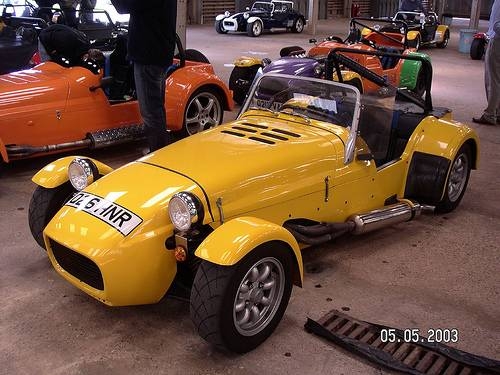
A kit car is not quite what the name implies. It is not a "car kit" with everything included in a box. Instead, a kit car is typically a quantity of parts designed to retrofit an existing car, car body, frame or suspension to look like an old, rare or other desirable vehicle. Kit cars come in a variety of styles and levels of difficulty. You can think of a kit car as a full-size model car that you can drive.
Kit cars arrive by truck, or can be picked up at the manufacturer's outlet or factory. They usually weigh hundreds--if not thousands--of pounds, so allowances must be made for shipping or local pickup. Kit cars are designed to utilize outside parts, usually "cannibalized" from an existing car. Many kit cars are titled as the car the original parts came from. Consequently, if you buy a kit to make a Mercedes Gazelle on a Volkswagen frame, and it will be titled as a Volkswagen. As a result, it's a good idea to choose a donor car that has no title or VIN number problems.
Kit cars come in various levels of difficulty to create. Some are very simple to build, and require only bolting together of the parts and minor fitting. Some, on the other hand, are quite difficult to build. These may require large amounts of welding, fabricating, and modifications to work. The kit manufacturer should give some indication of the labor involved in building a kit that they sell. All kit cars are labor-intensive, and many require months if not years of free time to fully assemble.
Most kit cars come pre-painted, and you must exercise care in handling any fragile or hard-to-replace parts. Remember that the donor car will provide the power train, including engine and transmission, and that these parts should be in top condition before they are installed in the kit. Brakes, steering, suspension and many other parts will be recycled from the donor. Take care to ensure they are all in serviceable condition prior to installation.
When the kit is assembled, it is essentially the same car as the donor car, with all of the donor car's inherent problems. If you don't like how a Volkswagen runs, don't build a kit which requires a Volkswagen donor car, because with the exception of its looks, it will still be a Volkswagen. Kit cars are usually selected based on the availability of donor cars at a given time. At one time Volkswagen, Ford Mustang II, Ford Pinto and Chevrolet Chevette were the most common types as these were widely available in junk yards and from private individuals. More modern kit cars use Pontiac Fiero and other relatively recent models.
Availability of replacement parts and dependability of the donor car should be paramount when making the decision as to which kit to purchase. Avoid kits that require obscure donor cars, or donor cars that tend to be undependable. Don't bite off more than you can chew. A kit car is a monumental task to undertake for a single individual, and usually help is required with some of the heavy lifting and moving of parts. Ask questions and research your potential purchase thoroughly before buying (see Resources below).